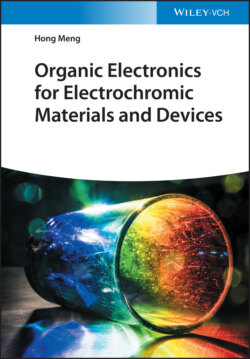Читать книгу Organic Electronics for Electrochromic Materials and Devices - Hong Meng - Страница 31
2.3.5 Ionic Liquid Polymer Electrolytes
ОглавлениеILs are molten salt liquid at room temperature (<100 °C) and consisted of dissociated ions [118]. IL electrolytes have been widely applied in electrochemical application due to non‐volatility, thermal stability, non‐flammability, high ionic conductivity, and a wide electrochemical stability window [119]. Recently, the incorporation of room‐temperature ILs into PEs to prepare solvent‐free PEs has been considered as a promising approach to improve the performance of ECDs. For example, room temperature ionic liquid (RTIL) (1‐butyl‐3‐methyl‐imidazolium hexafluorophosphate [BMIM] PF6) [120] was reported to increase the optical contrast and coloring efficiency of the ECD. Zhou et al. have studied an RTIL non‐volatile polymer electrolyte based on poly(propylene carbonate) as the host for ECD application [121]. In this work, 1‐butyl‐3‐methylimidazolium tetrafluoroborate (BMIM+BF4−) with high ionic conductivity, good electrochemical stability, and low viscosity was added into poly (propylene carbonate) (PPC)/LiClO4 SPE to form novel PEs with improvement in ionic conductivity, thermal and electrochemical properties, and safety [121]. Recently, combining RTIL and ceramic filler into PEs have been explored. Murali and coworker [122] studied zinc ion conducting gel polymer electrolytes (ZCGPEs) made of poly(vinyl chloride) (PVC)/PEMA blend, zinc triflate [Zn(OTf)2] salt, 1‐ethyl‐3‐methylimidazolium bis(trifluoromethylsulfonyl) imide (EMIMTFSI) IL, and silica (SiO2), which exhibited the highest ionic conductivity.
PILs are polyelectrolytes consisting of a polymeric backbone and IL components in monomer repeating units. Variability and designability of ILs enrich the performance, which attract great attention in the field of polymer material [123]. Mecerreyes in 2011 reviewed the synthetic aspects of ILs, the synthetic methods of PILs, and their physicochemical properties [124]. Yuan et al. also reported the applications of PILs and ILs [125]. ILs can be widely applied in diverse field through adjusting ionic conductivity, hydrophilicity, hydrophobicity, chemical durability, and thermodynamic stability. Marcilla et al. [126] have reported a new PE based on ILs and PILs in ECDs having configuration PEDOT/electrolyte/PEDOT. The electrolyte was prepared by mixing 1‐butyl‐3‐methylimidazolium‐bis(trifluoromethanesulfonimide) [bmim][Tf2N], 1‐butyl‐3‐methylimidazolium tetrafluoroborate [bmim][BF4], and 1‐butyl‐3‐methylimidazolium bromide [bmim][Br], with poly(1‐vinylethyl‐imidazolium) bearing similar counter anions [Tf2N], [BF4] and [Br]. By using this electrolyte, the cycle life was significantly increased. Hydrophobic ILs (P(EO)10 lithium bis (trifluoromethanesulfonyl) imide (LiTFSI) + 0.96PYR14TFSI) electrolyte was reported to improve the performance of the all‐solid‐state ECD [127]. Puguan and Kim reported a switchable single‐molecule ECD derived from a viologen‐tethered triazolium‐based poly(ionic liquid) (Figure 2.10) [128].
Figure 2.10 A switchable single‐molecule electrochromic device derived from a viologen‐tethered triazolium‐based poly(ionic liquid).
Source: Puguan and Kim [128].
Yuan's group reported a flexible and voltage‐switchable polymer Velcro constructed using host–guest recognition between poly(ionic liquid) strips. [129] The reversible phase transition behavior of PILs can be activated by temperature, electrochemical redox reactions, and chemical redox reactions. Vancso and coworkers prepared a redox‐active organometallic PIL [130]. The prepared polymer Velcro based on PILs exhibited strong adhesion in air and in aqueous solutions (including acidic and basic water and artificial seawater) and could be unfastened and fastened by mechanical, chemical and electrochemical means (Figure 2.11).
Figure 2.11 Schematic representation of the synthesis of PIL‐b‐CD and PIL‐Fc membranes and the hook‐and‐loop strategy for adhesion based on b‐CD and Fc‐modified PIL membrane surfaces.
Source: Guo et al. [129].
